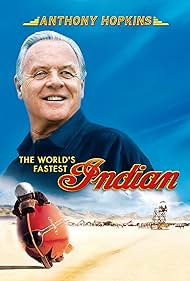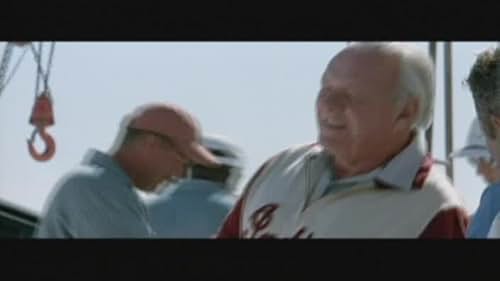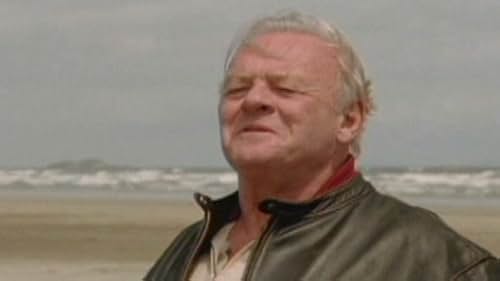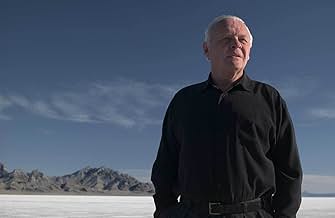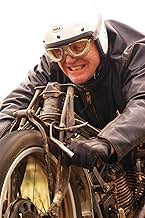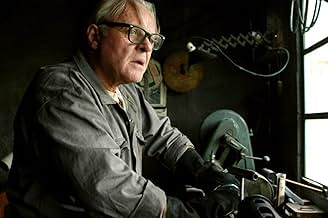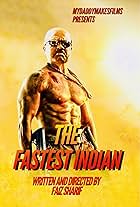The story of New Zealander Burt Munro, who spent years rebuilding a 1920 Indian motorcycle, which helped him set the land speed world record at Utah's Bonneville Salt Flats in 1967.The story of New Zealander Burt Munro, who spent years rebuilding a 1920 Indian motorcycle, which helped him set the land speed world record at Utah's Bonneville Salt Flats in 1967.The story of New Zealander Burt Munro, who spent years rebuilding a 1920 Indian motorcycle, which helped him set the land speed world record at Utah's Bonneville Salt Flats in 1967.
- Awards
- 11 wins & 6 nominations total
- Director
- Writer
- All cast & crew
- Production, box office & more at IMDbPro
Featured reviews
Greetings again from the darkness. Writer/Director Roger Donaldson has been very prolific in his Hollywood career creating mostly slick, ho-hum projects such as "The Recruit", "Thirteen Days", "Dante's Peak" and "Cocktail". Although there is a touch of sap in this one, Donaldson turns on the charm for the fascinating tale of Burt Munro, the New Zealander who shocked the world with his speed records in the 1960's.
Playing a bit like a motorized "Hidalgo", the film captures your heart and imagination thanks in large part to the amazing journey of this spirited man and the terrific performance of Sir Anthony Hopkins. Making his way half way around the world with almost no money to his name, Munro realizes a life long dream of running his hand-built 1920 Indian "motor-sickle" at the Salt Flats of Bonneville in Utah. his journey and openness introduce him to so many people along the way. His warm heart and courage just will these folks to help him out. Everyone wants ol' Burt to make it.
While you may think to yourself this is just a light-hearted Hollywood feel-good film, just remember the man and the story are real. Donaldson and Hopkins worked together over 20 years ago in "The Bounty" and have another very interesting project under way now with "Papa" - a biopic on Ernest Hemingway. Three supporting performances really stand out: Diane Ladd, (comedian) Paul Rodriguez and Christopher Lawford (Peter's son) as Jim Moffit. Donaldson, in a nice touch, also spreads in a few appearances of the guys from the high speed world.
This is one you can take the family to and almost everyone will enjoy the story, journey and spirit of Burt Munro. And believe me when I say, you will never look at Lemon trees the same again!!
Playing a bit like a motorized "Hidalgo", the film captures your heart and imagination thanks in large part to the amazing journey of this spirited man and the terrific performance of Sir Anthony Hopkins. Making his way half way around the world with almost no money to his name, Munro realizes a life long dream of running his hand-built 1920 Indian "motor-sickle" at the Salt Flats of Bonneville in Utah. his journey and openness introduce him to so many people along the way. His warm heart and courage just will these folks to help him out. Everyone wants ol' Burt to make it.
While you may think to yourself this is just a light-hearted Hollywood feel-good film, just remember the man and the story are real. Donaldson and Hopkins worked together over 20 years ago in "The Bounty" and have another very interesting project under way now with "Papa" - a biopic on Ernest Hemingway. Three supporting performances really stand out: Diane Ladd, (comedian) Paul Rodriguez and Christopher Lawford (Peter's son) as Jim Moffit. Donaldson, in a nice touch, also spreads in a few appearances of the guys from the high speed world.
This is one you can take the family to and almost everyone will enjoy the story, journey and spirit of Burt Munro. And believe me when I say, you will never look at Lemon trees the same again!!
10DaRitz
Seeing the movie "The World's Fastest Indian" reminded me why I go see movies. I average about one every two weeks, and this was one of those rare movies that actually made me feel *happy* afterward.
The main character, New Zealander Bill Munroe as played by Anthony Hopkins, is a true man's man. He has spent his entire adult life tinkering with his streamlined motorcycle, a 1920 Indian (hence the title.) Now in his 60's in the year 1963, he wants to realize his life's dream of taking it halfway around the world to the Bonneville Salt Flats Test Track in Utah, the only place where he can find out how fast it will actually go.
The movie pulls off two often-used themes, The Long Journey and Overcoming Adversity, without a hint of phoniness or melodrama. The Long Journey from New Zealand to Utah takes up most of the movie, with Munroe scrounging up travel money, working off part of his passage on a dilapidated freighter, and the long, event-filled drive from the California coast to Utah in an old used car. Overcoming Adversity is portrayed in two ways: by Munroe's awesome mechanical genius as shown by his ability to fashion spare parts out of almost anything and to improvise a la MacGyver, and in his charm and likability when confronted with more human obstacles. Indeed, one of the movie's chief strengths was the character's ability to make friends easily under any situation, with a cast of colorful supporting characters who wonderfully complemented Hopkins' acting.
After finally reaching the test track, the movie's focus shifts from the acting to the cinematography and drama. The dozens of colorful cars, motorcycles, and drivers' outfits contrast strikingly with the blinding white of the salt flats and the mountainous backdrop. And when Munroe finally gets the chance to make his test run, two questions come to mind. How fast can he go? More importantly, will the 64-year-old man and the 43-year-old patched-up bike hold together under the strain?
After seeing the movie and while still in my euphoric state, my skeptical mind wondered how much of it was actually true. I did a little research, and the portrayal of this amazing man seems to be true enough. Go see this movie; if you do, you'll leave the theater feeling good, and perhaps even a little inspired.
The main character, New Zealander Bill Munroe as played by Anthony Hopkins, is a true man's man. He has spent his entire adult life tinkering with his streamlined motorcycle, a 1920 Indian (hence the title.) Now in his 60's in the year 1963, he wants to realize his life's dream of taking it halfway around the world to the Bonneville Salt Flats Test Track in Utah, the only place where he can find out how fast it will actually go.
The movie pulls off two often-used themes, The Long Journey and Overcoming Adversity, without a hint of phoniness or melodrama. The Long Journey from New Zealand to Utah takes up most of the movie, with Munroe scrounging up travel money, working off part of his passage on a dilapidated freighter, and the long, event-filled drive from the California coast to Utah in an old used car. Overcoming Adversity is portrayed in two ways: by Munroe's awesome mechanical genius as shown by his ability to fashion spare parts out of almost anything and to improvise a la MacGyver, and in his charm and likability when confronted with more human obstacles. Indeed, one of the movie's chief strengths was the character's ability to make friends easily under any situation, with a cast of colorful supporting characters who wonderfully complemented Hopkins' acting.
After finally reaching the test track, the movie's focus shifts from the acting to the cinematography and drama. The dozens of colorful cars, motorcycles, and drivers' outfits contrast strikingly with the blinding white of the salt flats and the mountainous backdrop. And when Munroe finally gets the chance to make his test run, two questions come to mind. How fast can he go? More importantly, will the 64-year-old man and the 43-year-old patched-up bike hold together under the strain?
After seeing the movie and while still in my euphoric state, my skeptical mind wondered how much of it was actually true. I did a little research, and the portrayal of this amazing man seems to be true enough. Go see this movie; if you do, you'll leave the theater feeling good, and perhaps even a little inspired.
Invercargill, New Zealand, is noted for being the country's southernmost city and for having the least hours of sunshine and the most number of rain days of any NZ large town. It is also famous for being the home town of a gritty old codger called Burt Munroe who set a number of world motor cycle speed records (one of which still stands) in the 1960s at Bonneville Salt Flats, Utah, riding a 1920 Indian Scout motor cycle.
Roger Donaldson, one of the midwives to the renaissance of the Kiwi film industry in the 1980s ("Sleeping Dogs", "Smash Palace") and latterly Hollywood director ("Thirteen Days"), made "Offerings to the God of Speed" a documentary on Burt in 1972, when he was still alive. This dramatization of the same story little man triumphs though sheer grit and determination is a triumph for his star. Anthony Hopkins is good at quirky curmudgeons but here he manages to exude a little homespun charm as well. His Burt has the happy knack of getting people to help him rather than shaft him. Officialdom melts at his approach and he is even attractive to the ladies, as Burt would have put it. It's Tony Hopkin's film and he carries it off in fine style. I'm not sure about the accent which is more northern British than southern NZ but it hardly matters as the Americans in the film can scarcely understand it anyway.
The rest of the cast were all adequate and Aaron Murphy as Tom the kid from next door was actually able to steal some scenes. I also noticed an old acquaintance in a minor role as Frank the bike club president - Tim Shadbolt, student radical of the late 60s and now mayor of Invercargill. Burt had no money but he did get community support at various times, so Invercargillians can take some pride in his achievements.
Which brings me to what I think is the hole in this account. The Indian motorcycle, which was a light machine used for dispatch and scout work in World War One, had a top speed, according to the makers, of 57 mph. It had a V-2 cylinder block design and a decent capacity of just under 1000cc. Burt was a backyard mechanic who constantly tinkered with it, even casting his own pistons, which blew with monotonous regularity. Somehow he got the thing to exceed 200mph. No doubt the streamlining helped, but he must have modified the original design radically. Donaldson presents this without any explanation. Maybe Burt wouldn't tell him, or maybe Donaldson thought too much tech stuff would put the punters off. It wouldn't have taken much to explain it.
As others have said, this is very much a "feel-good" movie and I think, as an ex-resident of NZ, evocative of some of the more admirable aspects of the NZ character the optimism, the friendliness, the capacity for improvisation and the willingness to rise to a challenge, and even occasionally to take risks. Burt had a lot in common with those pioneer settlers from Scotland who arrived in Southland 100 years earlier and founded Invercargill, a place the Maori sensibly regarded as a trifle too chilly to actually live in (though they visited for the oysters and muttonbirds). But he also had some home-grown attributes as well. .
Roger Donaldson, one of the midwives to the renaissance of the Kiwi film industry in the 1980s ("Sleeping Dogs", "Smash Palace") and latterly Hollywood director ("Thirteen Days"), made "Offerings to the God of Speed" a documentary on Burt in 1972, when he was still alive. This dramatization of the same story little man triumphs though sheer grit and determination is a triumph for his star. Anthony Hopkins is good at quirky curmudgeons but here he manages to exude a little homespun charm as well. His Burt has the happy knack of getting people to help him rather than shaft him. Officialdom melts at his approach and he is even attractive to the ladies, as Burt would have put it. It's Tony Hopkin's film and he carries it off in fine style. I'm not sure about the accent which is more northern British than southern NZ but it hardly matters as the Americans in the film can scarcely understand it anyway.
The rest of the cast were all adequate and Aaron Murphy as Tom the kid from next door was actually able to steal some scenes. I also noticed an old acquaintance in a minor role as Frank the bike club president - Tim Shadbolt, student radical of the late 60s and now mayor of Invercargill. Burt had no money but he did get community support at various times, so Invercargillians can take some pride in his achievements.
Which brings me to what I think is the hole in this account. The Indian motorcycle, which was a light machine used for dispatch and scout work in World War One, had a top speed, according to the makers, of 57 mph. It had a V-2 cylinder block design and a decent capacity of just under 1000cc. Burt was a backyard mechanic who constantly tinkered with it, even casting his own pistons, which blew with monotonous regularity. Somehow he got the thing to exceed 200mph. No doubt the streamlining helped, but he must have modified the original design radically. Donaldson presents this without any explanation. Maybe Burt wouldn't tell him, or maybe Donaldson thought too much tech stuff would put the punters off. It wouldn't have taken much to explain it.
As others have said, this is very much a "feel-good" movie and I think, as an ex-resident of NZ, evocative of some of the more admirable aspects of the NZ character the optimism, the friendliness, the capacity for improvisation and the willingness to rise to a challenge, and even occasionally to take risks. Burt had a lot in common with those pioneer settlers from Scotland who arrived in Southland 100 years earlier and founded Invercargill, a place the Maori sensibly regarded as a trifle too chilly to actually live in (though they visited for the oysters and muttonbirds). But he also had some home-grown attributes as well. .
A true story with a nice mix of emotion and motorcycles.
At a sneak preview of this movie in Burt Munro 's hometown - Invercargill, I noticed at the end that many of the men had moist eyes -not that the film is weepy or sycophantic in any way - it's simply inspirational.
The hero/underdog here is a social misfit, a self-confessed dirty old man but a lovable one. He loves the ladies and he loves speeding on his vintage Indian Scout "modified somewhat" along the open beach of Invercargill in Southern New Zealand. Beach bike racers still contest the Burt Munro Trophy on Oreti beach.
Burt's 1967 record at Bonneville still stands.
Anthony Hopkins manages the problematic Kiwi accent well to deliver a touching, funny and realistic depiction of Burt in his quest to be the fastest thing on two wheels. Sir Anthony said that it's the best thing he's ever done and it's hard to disagree based on his laconic and lovable portrayal.
Outstanding cameos by the likes of Annie Whittle and Diane Ladd simply add depth and verisimilitude to the film. Tim Shadbolt, well he definitely acted in the film...
Complete and convincing performances that warm the heart and show true humanity shining through.
The cinematography is clear and precise, the action scenes are mercifully free of special effects and Burt's kiwi innovation and guile win the day.
A new classic from Roger Donaldson.
At a sneak preview of this movie in Burt Munro 's hometown - Invercargill, I noticed at the end that many of the men had moist eyes -not that the film is weepy or sycophantic in any way - it's simply inspirational.
The hero/underdog here is a social misfit, a self-confessed dirty old man but a lovable one. He loves the ladies and he loves speeding on his vintage Indian Scout "modified somewhat" along the open beach of Invercargill in Southern New Zealand. Beach bike racers still contest the Burt Munro Trophy on Oreti beach.
Burt's 1967 record at Bonneville still stands.
Anthony Hopkins manages the problematic Kiwi accent well to deliver a touching, funny and realistic depiction of Burt in his quest to be the fastest thing on two wheels. Sir Anthony said that it's the best thing he's ever done and it's hard to disagree based on his laconic and lovable portrayal.
Outstanding cameos by the likes of Annie Whittle and Diane Ladd simply add depth and verisimilitude to the film. Tim Shadbolt, well he definitely acted in the film...
Complete and convincing performances that warm the heart and show true humanity shining through.
The cinematography is clear and precise, the action scenes are mercifully free of special effects and Burt's kiwi innovation and guile win the day.
A new classic from Roger Donaldson.
I must admit, on this particular day I was dragged to the cinema with no prior knowledge of the characters, plot and had no awareness of the historical basis upon which the film is based. After a minute or so, I realized my partner (a fairly new motorcycle rider himself, making me a motorcycle widow of course) had lured me into a film about motorbikes. I rolled my eyes at him, yawned and prepared for the worst ...
What I got instead was the best film I've seen for quite some time.
Anthony Hopkins totally blew me away. His accent was really very strong (it should be noted that the Invercargil accent is pretty distinct from the rest of the South Island of NZ) and he managed to maintain the audience's interest though some pretty dialogue-heavy scenes. All of the supporting characters did a brilliant job defining a diverse physical and emotional landscape for the protagonist. The cinematography was economical and meaningful and assisted the humorous moments beautifully. The story unfolded very nicely and - thanks to some great editing - the small moments of tension were plentiful and kept the story moving along nicely.
With all the cynicism and politics in contemporary cinema, it is so refreshing to see a film that is very pure, that speaks volumes about kindness and passion and friendship without saying anything at all. This film didn't try to make any big statements, there were no lengthy diatribes about 'acceptance' and 'tolerance', and I loved that.
I left the cinema with a huge grin on my face. I'm so glad I was dragged along for the ride.
What I got instead was the best film I've seen for quite some time.
Anthony Hopkins totally blew me away. His accent was really very strong (it should be noted that the Invercargil accent is pretty distinct from the rest of the South Island of NZ) and he managed to maintain the audience's interest though some pretty dialogue-heavy scenes. All of the supporting characters did a brilliant job defining a diverse physical and emotional landscape for the protagonist. The cinematography was economical and meaningful and assisted the humorous moments beautifully. The story unfolded very nicely and - thanks to some great editing - the small moments of tension were plentiful and kept the story moving along nicely.
With all the cynicism and politics in contemporary cinema, it is so refreshing to see a film that is very pure, that speaks volumes about kindness and passion and friendship without saying anything at all. This film didn't try to make any big statements, there were no lengthy diatribes about 'acceptance' and 'tolerance', and I loved that.
I left the cinema with a huge grin on my face. I'm so glad I was dragged along for the ride.
Storyline
Did you know
- TriviaBurt Munro's children visited the set one day, when, according to writer, producer, and director Roger Donaldson, "Tony (Sir Anthony Hopkins) was having a particularly good Burt day." His performance was so authentic that it moved them to tears.
- GoofsBurt talks about his twin brother and tells Tom a story about how he died as a youngster. The real Burt Munro had a twin sister who died at birth.
- Quotes
Tom: Aren't you scared you'll kill yourself if you crash?
Burt Munro: No... You live more in five minutes on a bike like this going flat out than some people live in a lifetime.
- ConnectionsFeatured in The Daily Show: Anthony Hopkins (2006)
- SoundtracksYou Are My Sunshine
(Jimmie Davis / Charles Mitchell)
© Peer International Corp
Used by permission. All rights reserved
Details
- Release date
- Countries of origin
- Official site
- Language
- Also known as
- El amo del viento
- Filming locations
- Production companies
- See more company credits at IMDbPro
Box office
- Budget
- $25,000,000 (estimated)
- Gross US & Canada
- $5,128,124
- Gross worldwide
- $18,302,013
- Runtime2 hours 7 minutes
- Color
- Sound mix
- Aspect ratio
- 2.35 : 1
Contribute to this page
Suggest an edit or add missing content

Top Gap
What was the official certification given to The World's Fastest Indian (2005) in Japan?
Answer